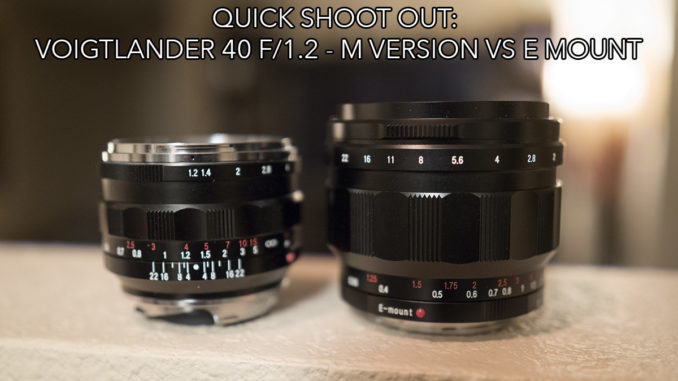
Quick Shoot Out: Voigtlander 40 f/1.2 M Mount vs Voigtlander 40 f/1.2 E Mount!
By Steve Huff
Hey guys! Today I have a quick comparison for you. A few asked me if I could compare both versions of the new(ish) Voigtlander 40 f/1.2. The M mount, or the VM and the Sony E Mount. I have reviewed the E Mount version (see that here) and LOVED it. So much so that it is now on an A7RIII as I type this. Awesome lens for the Sony in E mount because it feels like an old school lens, looks like an old school lens, and is manual focus. Of course, if you like that sort of thing. The 40mm focal length is in the middle between 35 and 50 but the fast f/1.2 aperture is what really makes this a unique lens as it can suck in the light, and do very well in any lighting scenario. I now have a Leica M10 here with me (again) and the new Voigtlander 40 f/1.2 in M mount. So I have both versions of the lens here, now which is pretty cool. I will be doing a much better comparison this weekend, but for today I just wanted to throw up a few quick shots taken with each as there is a difference.
The M mount version is quite a bit smaller than the Sony version and feels really nice, just as nice of a focus feel as the Sony in fact. I have to admit though, after testing the M version on a Leica M10, man this combo is beautiful in size, feel, weight. Been a while since I shot with an M, and now that one is here in my hand again, well, you know.
The Sony is also quite the camera, and with this lens makes for a really nice and FUN versatile set up. A few images below…more to come in a few days, along with a new video (as well as updated thoughts on the Leica M10!)..
Click images for larger and better versions..
OK, right off the bat I see a difference in not only the depth of field, but the bokeh is also different between the two lenses. Same aperture for both, wide open.
–
These two look similar at first glance but again, bokeh is different and the M mount seems to bering a more shallow DOF using the same aperture.
–
See any difference here?
–
And the crops! Click the image to see a true 100% crop embedded.
So far with only a day with this in hand, I already see a difference between the M mount and E mount versions of this lens. The M seems to give a more shallow DOF, and the bokeh renders differently. More to come!!
The M10 came to me via KEN HANSEN, whom I sent an email and said “I WANT TO BUY AN M10”!! Couple days later it was on my doorstep like Magic. Ken is the MAN. Looking for Leica, you can email him at KHPNY19@aol.com

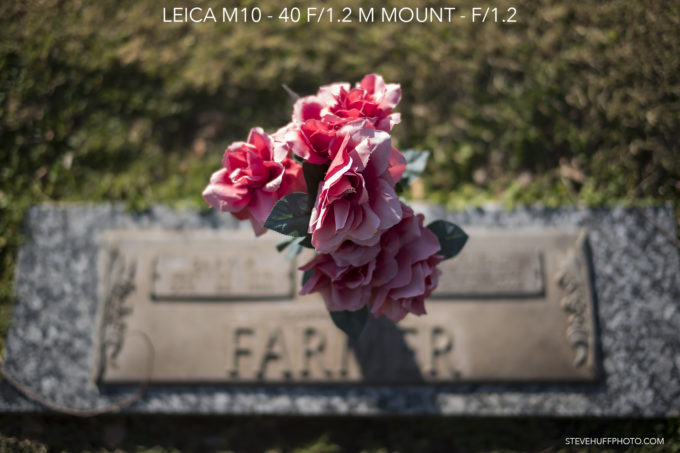
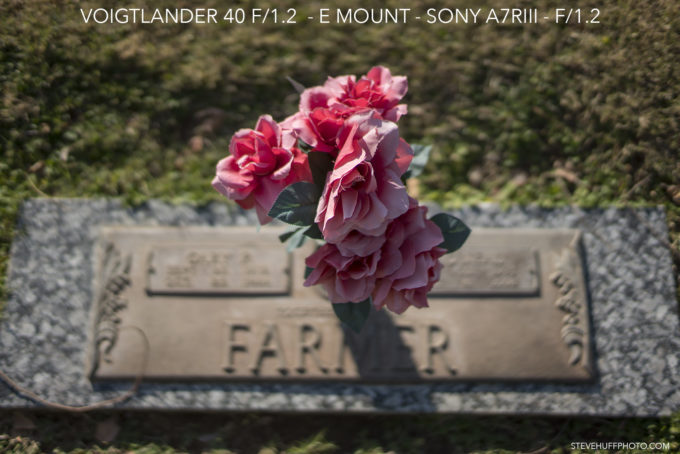
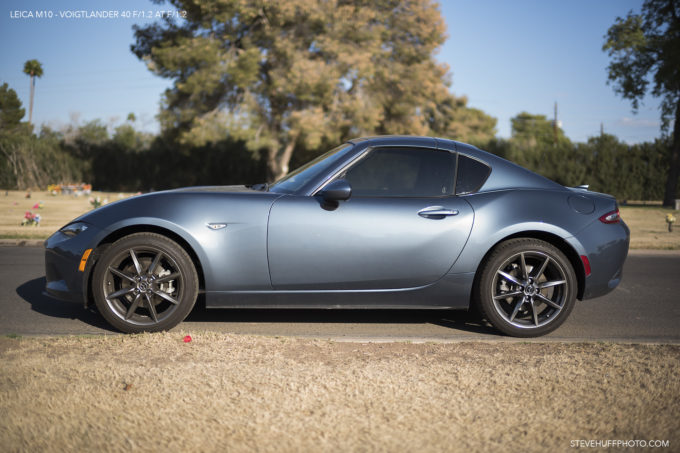
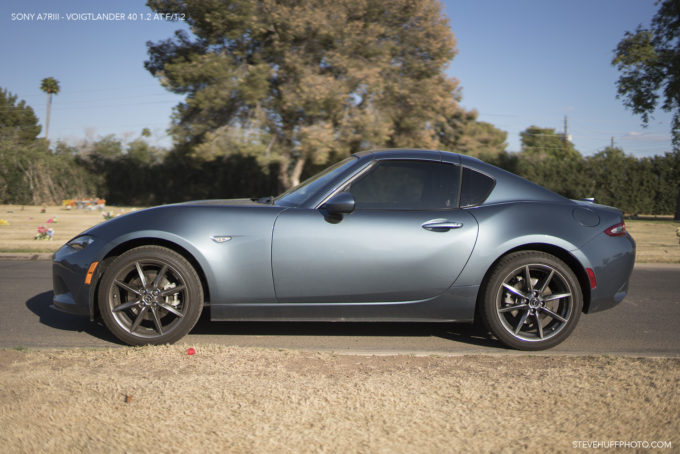
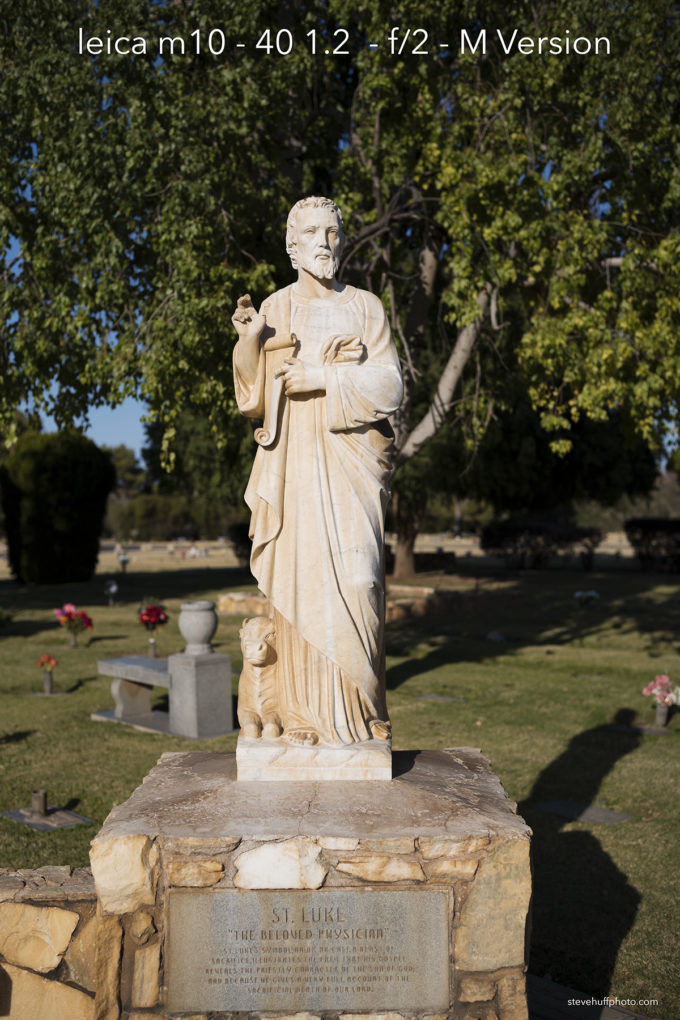
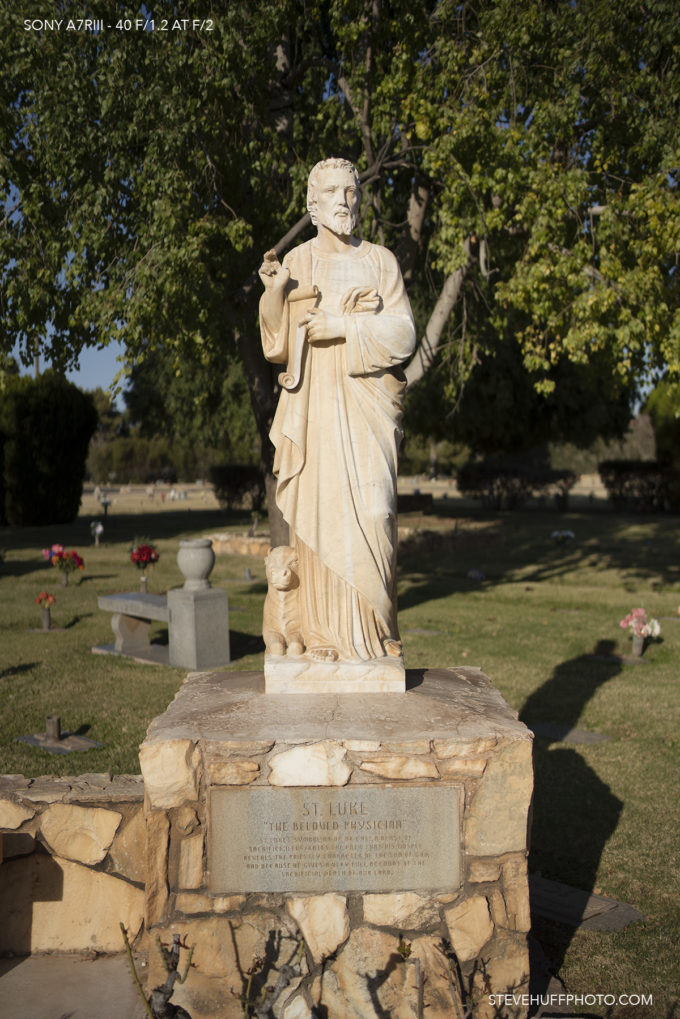
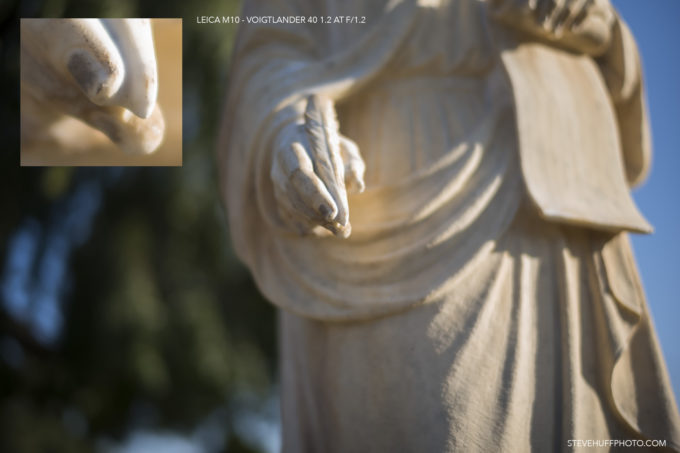
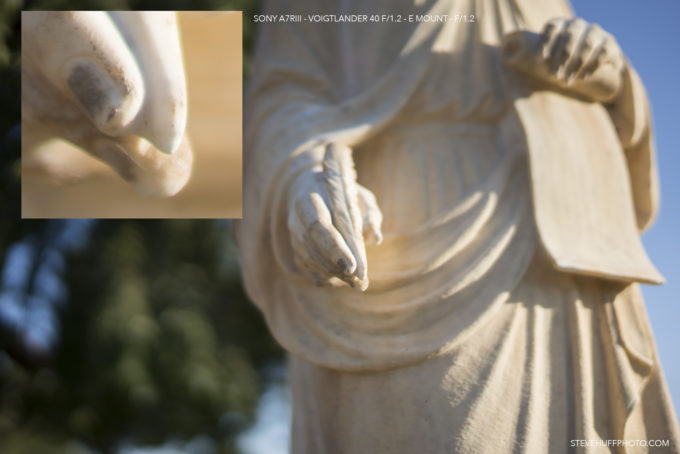
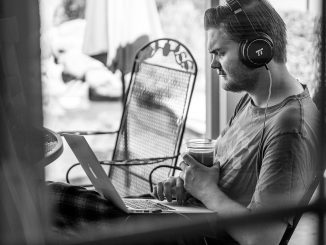
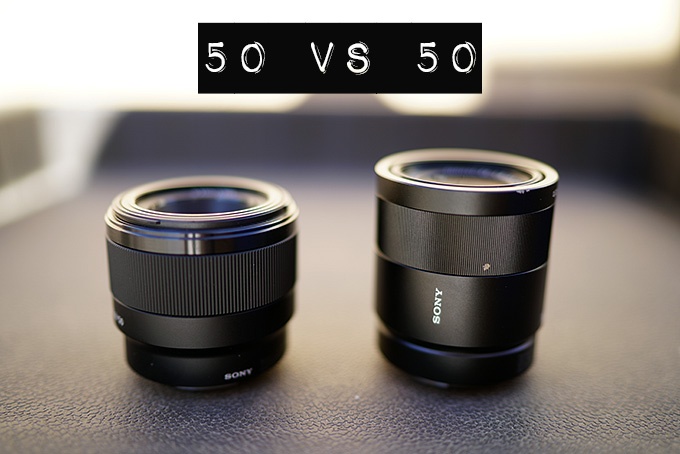

Hi Steve,
thanks for sharing these – very useful!
As you’re aware, the difference in DOF mostly comes from Sony’s EFC and full e-shutter.
I’m lucky enough to shoot M10 + 50 APO Cron and 35 Lux FLE, but I see tons of magic, character and brutal 3D from this amazing Voigt. and I want it for sure.
And this is where the confusion starts, because I’ll be getting also my A7RIII in 3 days, so I’m moving back and forth which mount to buy, if not both (which will be stupid) for keeping the IQ at peak level on both.
I’ve read a lot that adapted lenses don’t deliver their maximum when paired to Sony due to Sony’s field curvature on sensor micro lenses and specific lens design this is prompting for. To add to that, I wonder which M->E adapter is the considered to be the best one? I’ve tried my 50 APO on a A7RIII with Voigt M->E adapter and it worked comparatively well, although still far away from the results it delivers on M10.
So, I maybe getting the 40/1.2 Voigt in E-mount ver. just to keep the Sony RIII small and lite and keeping the M10 for Leica lenses… What would you do if you step into my shoes? Which version will you be getting M or E, or both to benefit from the contacts in the E-version?
To add to the above, I’m really missing a decent 50mm prime in Sony world (hardly dislike the ugly, busy and nervous character on their Zony 50/1.4 with the ever famous Zeiss lemons in the defocus), so I might go well with this Voigt until we see a decent 50GM prime…
Would you mind sharing your thoughts?
Thanks!
Hi Steve…. 40 is my favorite focal length. More so when shooting a Leica m….. have you observed any focus shift on the 40 with the Leica m10? Is focus reliably spot on from 1.2 to 2.8?…. thank you for your thoughts!
I have yet to notice any focus shift in my use, and I have used it quite a bit.
Hi Steve, Love your reviews and all your work. BTW, I just moved from Phoenix to Seattle. Been wanting to get into photography for a long time but due to some OCD tendencies have been procrastinating on what equipment to buy. I would like to lay out what I am thinking and would be really grateful for some feedback.
What I plan to photograph:
1) my aging cat
2) street photography in Seattle
3) to take with while hiking
4) making some cool mini macro prints for wall art (eg flowers etc)
what equipment I was planning on getting:
1) i really have been waiting for the new RX1R3 to come out but am getting tired of the wait … many rumors pointed to Q1 of this year but nada … it would offer the best package for me
2) A7RIII with these 2 lenses: voigtlander 40 1.2 for street and hiking and 85 1.4 for taking pics of my cat
I dunno what to do.
Do you have any idea when RX1R3 might be coming out?
I doubt a RX1R3 will ever make it, but for what you describe I would go for the A7III and Highly recommend the 40 1.2 s well. The 85 1.4 is nice but large. If you want an 85 for cat photos, the 85 1.8 is also fantastic and much smaller.
Also note that if the blur disc are truncated, they’ll appear to be a bit smaller in extent, and therefore sharper, and that increased subjective sharpness / reduction of blur size will cause an apparent increase of DoF, and therefore a reduction in the subjective separation between the sharp subject and the blurred background.
Looking at the truncated bokeh blur discs, it’s obvious the Sony pictures were taken with electronic first curtain shutter (EFCS) on.
At shutter speeds above the flash X sync speed, the film surface (or, with digital cameras, the electronic sensor surface) is never entirely uncovered during exposure by a mechanical focal plane shutter. Instead, the exposure is performed by a a travelling, open slit formed between the first and second curtains.
On a 24x36mm caemra, the flash X sync speed of a vertically travelling shutter might be 1/250s. This is the time the opening between the first and second mechanical curtains takes to travel 24mm.
At a shutter speed of 1/500s, the width of that travelling slit would be about half the slit width at 1/250s — i.e. about 12mm.
And at a shutter speed of 1/2000s, the width of the travelling slit might be only 3mm.
https://www.youtube.com/watch?v=fyqbIuTzRVI&t=1m16s
When one enables EFCS mode on a mirrorless camera, the first mechanical shutter curtain’s function is implemented by a a electronic signal that travels across the image sensor at a speed similar to a mechanical shutter curtain.
That signal tells the image sensor’s pixels to start the exposure.
Then, after the required exposure time has elapsed, the mechanical second curtain closes, thereby ending the exposure.
Only the first curtain is “electronic”, in the sense that it’s a fully silent and vibration-less electronic signal that replaces the mechanical first curtain.
While the electronic first curtain travels and acts directly on the sensor’s pxiels, the mechanical second curtain flies a few mm “above” the sensor. At high shutter speeds, where the shutter slit width will be only a few mm, this starts to matter because the angle at which a light ray impinges on the shutter curtains will markedly affect the duration during which that light ray can hit the uncovered pixels — i.e. the exposure time.
Fast — e.g. f/1.2 — lenses project a wide light cone, and the light rays forming the envelope of that cone are quite oblique. This obliquity, combined with the narrow slits caused by high shutter speeds will cause, if EFCS is on, the characteristic truncated blur discs.
This is well explained here:
https://www.dpreview.com/forums/post/56303687
The truncated blur discs in the background foliage of the pictures of the two small, red vending machines, caused by a fast lens + fast shutter speed + EFCS combination, are also pretty evident here:
http://www.stevehuffphoto.com/2014/04/28/first-look-preview-the-mitakon-50-f0-95-full-frame-lens-with-the-sony-a7/
Steve, can I ask reason of difference in dof between these two, or am I missing somethiong? The subject separation in Leica is exceptional!
Not sure really, to be honest. I did a updated post with the Leica version on the Leica. The M mount I have here is sharper than the E mount I have here wide open.
As a A7rIi and M240 owner, glad I stumbled across this last night. Eagerly awaiting your findings Steve before deciding which mount to purchase.
I did more shooting with it, and will have a review soon, but also put up this video with a few more shots…
https://www.youtube.com/watch?v=KC8lHcnVBmg
The pro to the E mount is the fact that it has electrical contacts so will record the EXIF as well as magnify automatically when you focus. The M mount is half the size, and of the two lenses I have here, a tad sharper than the E mount.
Thanks Steve, I spotted your video shortly after posting this, switched on notifications for your YouTube vids now! :-). Leaning towards the M mount but I saw reports of it smearing badly at the edges when on the Sony, though starting to think the user had a bad version based on what I see with your shots. Keep up the great work Steve!
Thanks Jonathan!
I’m blown away by the Leica combo, it makes the Sony look flat and ordinary. I feel like selling all of my Sony gear and getting a Leica.
My feelings exactly. The Leica images have much more presence and 3D quality. No contest. Based on this sample size of one, if I were a Sony shooter, I would not get this lens.
Or I would switch to Leica. ; > )
It doesn’t seem all that sharp wide-open on either camera. Perhaps the bokeh changes with distance of the rear element to the sensor or perhaps the micro lenses unique to each sensor.
It’s about as sharp wide open as the $11k Leica Noctilux is wide open but this is f/1.2 over f/0.95. If you see my review of the E mount it shows it is pretty sharp even at f/1.2, at least as sharp as I would ever need at that kind of aperture. The M mount version is actually a tad sharper wide open from what I am seeing.
Well if the M10 is sharper then we will all buy that one!
The main differences I see are the colors.
Differences in output could be caused by the different cameras used, not by anything related to lenses. If you don’t try the two lenses in at least one camera and compare the results, we don’t know if lenses peform equal “per se” or they don’t.
I have VM40/1.2 adapted via Techart LM-EA7 on A7R3. You can use AF and eye focus for portrait easily.
Hi Steve,
Since you are shooting both lenses at f1.2, I’m sure you were using high shutter speeds. It would be worth making sure that you have EFC (electric first curtain) or full electric shutter turned off on the aRIII. I’ve read forums and seen examples of how EFC affects the Bokeh with shutter speeds above 1/2000.
It’s off. Thank you!
I have been using the new 40mm F1.2 Voightlander lens on my Sony A7RIII for several weeks. It is an amazing lens: light weight, incredibly sharp and a joy to use. It takes me back to my early rangefinder focussing days. Instant focus magnification at any slight turn of the focusing ring allows easy almost instantaneous precise focussing at any desired point of the image. I thought I would need focus peaking. But actually, there inso need for it since the sharpness of detail is easily obtained. Then a simple slight press of the exposure button brings the entire frame instantly back and the full press takes the picture.
I love the 40mm focal length. It is in the sweet spot between 35 and 50mm. 50 mm has always been the way I see naturally, but 40 mm has become the new favorite for me because of the bit of extra frame width and the depth of field that it brings. This lens/camera combination has now become my favorite ‘walk about’ companion. The 43 mega pixels gives me incredible crop capability and eliminates the need for medium telephoto.
Altogether a great combination.
I always thought the sensor on Leica M was an APS-H so there was a crop of 1.2X
All digital Leica M’s after the initial M8 use full frame sensors. They have no crop, but are indeed full frame.
Good to know, still too poor to afford one haaa!
Hi Steve I want to buy new lens for my Leica m10 should I buy the nokton 35 1.2 ii or the new 40 1.2?
I would love to know your opinion.
Thanks
Well, the 40 1.2 is a better lens than the 35 1.2 IMO. That lens is sort of showing its age these days. But the 40 will be a tad odd to use on the M, as it brings up the 50mm framelines. Using an external VF for the M is a pain, as you have to use the normal VF to focus, then the external to frame. So I would probably buy the 35 1.2 II over the 40 for that reason (but not positive on that yet), on an M. If the slight difference in the frame lines doesn’t matter to you then the 40 1.2, IMO, is the better lens.
I was going to come up with the same request as Wolfington, comparing both lenses on the Sony body. Maybe you can also compare sizes, when the adapter is put on the VM.
Yet another one who’s really looking forward to your next post! 🙂
Thanks Dirk, will do. Going to shoot them both today, and will test the M version on the Sony as well. Should be interesting, and fun as well!
I thought that to compare optics of two lenses one should use the same camera, in this case Sony. Unless you compared how they look on two different cameras. That`s another story.
No not here in this test. Many have said these lenses had the same optical formula. Maybe they do, and it is the camera sensors showing the differences. If so, I prefer the M rendering by far. But this is showing each lens, used on the camera it was made for. I would not buy the M mount if I owned a Sony, I would buy the E mount as it was made for the Sony and offers conveniences the M would not. The E mount of course can not be used on the Leica. So this is showing the supposedly same lens on two bodies, showing the difference in output. Many say Leica’s render the same as other cameras. This may show that is not the case all of the time. Or could be the lens. Will test the M mount on the Sony today and see if it is a lens thing or camera thing ; ) Thank you!
WOW I m astounded by the difference. The M mount version is clearly superior. Now what would be really nice is to compare both on the Sony via Leica to E-mount adapter. Then we could see clearer whether it s just the lense or camera body that makes all that difference. I ve got a Sony A7III and a Leica CL (the old film one). So I m interested in the M mount version. Plus if I get the Techart adapter I potentially gain AF on Sony. Win win
Doing this today! Thank you!
Thanks Steve. As an m10 owner I have been looking at the 40mm and these shots are quite compelling. I noticed that the gradation from highlights to shadows is less abrupt on the Sony. Could this be because the exposure on the m looks like +0.5 compared with the Sony or could it be the lens or the sensor maybe?
I will find out today as I will be doing a slew of comparisons, and some with a tripod. Will also try the M lens on the Sony via adapter.
The Leica combo has so much more character to the rendering. Color and pop crush the sony as well.
Might be an interesting portrait lens on APS-C.
Maybe!
I heard from a friend that the CA on e mount version is weaker than the M mount. Can you the test also? Thanks steve
Very interesting early results, the M lens & M10 combo output looks crisper, punchier and especially the car shot more 3d than with the Sony.
When are you going to review the G9?
Do you think with nearly twice the pixels, the A7R3 is not the best comparable? How about your A9? That would be 24MP against the M10s 24MP.
I am comparing the rendering of the lens more so than resolution. Its a lens comparison not really a camera companion. Using the best camera each lens was made for ; )
Steve, surely better to test both lenses on the same body. reduces variables. M adapter you must have. you have ‘everything’ 😉 also is construction, materials used different? – one bseeming better than the other?
I think you said 24mp was sweet-spot in sensor size, somewhere. he-he, see I read and retain. I think it is & prefer to have AA filter in place. so there…. interesting comparison. thank you.
tombstone shots a bit downbeat, imo. never mind.simething with flesh-tone better.A.
Well I also wanted to see each lens on the body they were made for, which shows the Leica version is indeed rendering differently. If it is the camera, it says something about the M and its uniqueness. If it is the lens, it shows they are not the same lens as some have stated. Will be testing the M mount on the Sony today, along with the E mount, just for fun. Will also do more side by side as this was just a quick test.
great. are shots RAW or extra-fine jHPEG’s?-in all cases?
leica’s JPEG engines (algorithyms) gets commented on elsewhere yellowy-green casts on some L cameras, including the SL.(not you)there are so many potential combinations. the M10 results are likely to be different, because the M10 is very different, to most other cameras, maybe some aliasing artifacts rather like bang &olufsen hifi are ‘voiced’ to deliberately sound different to all other hifi – provides sales argument ‘different is better’, in comparison. of course, uniqueness does not necesarily herald ‘better’., just different.
Perhaps the difference in bookeh is because the pixel wells on the Sony accept a narrower angle of incoming light – they are ‘narrower holes’ – so that sensor cannot even ‘see’ the full aperture at 1.2 (of any lens, presumably). The Leica has a micro-lens array? The A7RIII does not. For these reasons, a comparison with the A9 might yield a different result – at f1.2 – but maybe not at f2.0.
Also, this could account for the similar bokeh in the corners of your test images – i.e., in the corners, the sensor is not getting f1.2, it’s actually getting f2 or smaller aperture – note that the center is darker in the sony – this is consistent with the narrow pixel well hypothesis. This appears to be a limitation of high density sensors.
A quick and dirty test is to set both cameras on 3′ and photograph a distant point light source (Venus?) in the corner and center at a fixed exposure and ISO – I predict the Leica (or A9) will show a larger circle of confusion than the sony in the center of the image when shot at f1.2, but they will be similar in the corner – and this difference will go away at f2.0 or maybe 2.8.
I like the look of the M10 better than the sony. The colors rendition looks so much better. The sony appears more grey on the first image. The car shones on the leica and looks flat on the sony. The statue especially the crop is better in appearance than the sony which looks blown out or less contrasty.
My thoughts.
It’s intersting that they would render differently though. Have you tried using an adapter with the M lens on the Sony body? I wonder how it would render? Fun test, Steve! 🙂
Have not yet tried the M on the Sony but will this weekend. Thanks!
Right on. Can’t wait to see the results!
Thanks!
In the shot of the statue, you seem to be standing much closer with the M10 shot?
Yes it does. I will have many more images this weekend, these were just quick snaps as I was on my way home. The 1st shot though, same distance yet you can see a considerable difference in DOF.
Yeah, that is interesting.
Was electronic first curtain shutter on A7rIII activated?
It leads to significant differences in bokeh rendering at faster shutter speeds.
Ahhh, will check that. Sony sent me this body to review and I have not checked that setting. Thanks for the tip.
I was about to mention this as well! Same with electronic shutter. Make sure you are full mechanical for the test and no silent mode. Very interested to see the results as I love the E-mount version.
I never use silent shooting modes. Only time I do is when I test it. Otherwise it is always mechanical as it was here. No silent mode was used here at all.
How come that electronic first curtain (or silent mode) might influence bokeh? I don’t understand this. Please enlighten me.